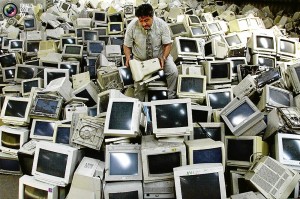Urban mining

AS MANY countries now start urban mining with e-waste to save the planet’s remaining primary materials of precious gold, silver, copper and rare earths, hopefully our country will adopt environmentally responsive waste disposal before we embark on utilizing the wealth of resources in e-waste management. totally cool pix.com
The word mining has gained such notoriety these days due in large part to the destruction of our environment by some companies and their indiscriminate mining operations.
However, there is now an interesting type of mining to utilize electronic waste or e-waste in our midst that is being studied because of the rich opportunities hidden.
Our wants have multiplied over our needs in this consumerist culture. Now our raw material supply is running out. It is costing us more to mine precious metals than to recycle and reuse mountains of obsolete and thrown-away electrical and electronic equipment that contain gold, silver, copper and other metals.
Capitalism has succeeded to motivate consumption in order to increase production. For example, an attractive well-lit and overcooled mall, according to psychologists, stimulates customers to feel good and get ready to swipe their credit cards. Social signaling through conspicuous spending can assure status and dominance.
Ethical consumption and culture built around consumption is being resorted to. Healthy and edifying experiences are being provided in shopping centers to enrich the human experience aside from buying and acquiring material goods.
What is urban mining?
People in the city can now think how to make good and healthy use of obsolete and thrown-away electronic and electrical equipment. One ton of ore contains only 5 grams of gold, whereas one ton of old mobile phones bears 200 grams of gold, it is reported. The government assisted by appropriate other stakeholders will have to get involved here for just and healthy ways of metal extraction.
It is estimated that there are 70,000 tons of mobile phones in e-waste globally, and only 1,000 tons are being recycled. The loss in Europe is around EU5 billion, enough to relieve somewhat the crisis. The United States has the highest amount of e-waste followed by China. Just one year’s mobile phones and computers generated as e-waste in China have a value of 4 tons of gold, 28 tons of silver, and 6,000 tons of copper. Today they are watching backyard type small-scale operators who resort to harmful ways of metal extraction like incineration in China.
Critical metal resource strategy
Global environmental management companies are coming up to watch out for resource diplomacy and the development of technology for effective recovery and recycling of these resource-rich equipment in our midst.
Steel is the most recyclable of all metals, and a third of global steel production is made out of recycled material. One ton of steel scrap can save up to 1,400 kg of iron and around 400 g of coal, which are used for producing steel. One ton of produced steel saves 1.2 tons carbon emissions.
Zero waste
Recycling tin cans, glass, paper or plastic has been the subject of legislative act (Republic Act 9003) on solid waste management. Each barangay in the country has an Eco Center to assist the community members in waste segregation and disposal. The whole country is conscious of the need to compost wet garbage and to segregate all solid waste. All solid waste must either go back to the earth or back to the factory.
Still we generate 7,000 tons of waste in the metropolis daily, and only 10 percent is recycled and composted. More sanctions for violation of the law are needed. The garbage crisis in Baguio City today is a microcosm of the nationwide resistance to live zero waste.
As many countries now start urban mining with e-waste to save the planet’s remaining primary materials of precious gold, silver, copper and rare earths, hopefully our country will adopt environmentally responsive waste disposal before we embark on utilizing the wealth of resources in e-waste management.
For comments or inquiries, e-mail amadodejesus@gmail.com
